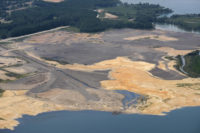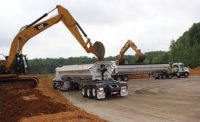Utility giant Georgia Power and a South Jordan, Utah-based producer of sustainable materials, have signed a deal to remove 8 million tons of coal fly ash from a retired coal-fired power plant over the next 15 years for use in concrete for infrastructure projects in Georgia and Florida.
Eco Material, which makes cementitious materials and carbon cement replacement products, announced the agreement Oct. 18, saying that about 600,000 tons of landfilled ash will be removed annually from Georgia Power's Plant Branch power plant in Putnam County, Ga. that was retired in 2015. The firm will construct a plant on-site to harvest the ash, expected to complete within two years.
The project will be the second fly ash harvesting project in the state, following a similar agreement Eco Material and Georgia Power announced in 2022 for fly ash harvesting at Plant Bowen in Bartow County, Ga., where construction of a plant is underway and harvesting is expected to begin by 2024.
At Bowen, Eco Material will also harvest 600,000 tons per year to a total 9 million tons of fly ash, according to a 2022 release from Georgia Power detailing the partnership, the largest of its kind in the country and the largest ever for Georgia Power.
Plant Branch will be Eco Material’s fourth ash harvesting and beneficiation facility. Once complete, the firm will have more than 3 million tons per year of the materials.
The company uses a proprietary technology to reduce high carbon content in landfilled and ponded coal ash, bringing it up to required specifications for use in concrete and other building materials.
“Most fly ash ends up in large infrastructure projects, including roads, bridges and dams, where specifications call for the durability performance benefits that fly ash use imparts,” says Eco Material CEO Grant Quasha. He says more concrete producers would use the material, including in non-spec projects, if it were available.
The fine residue resulting from combustion of pulverized coal, fly ash is well known as a supplementary cementitious material and has been in practice for decades, Quasha says. He cites the American Coal Ash Association, which reported a year-over-year increase from 11.1 million tons of ash to 11.9 million tons from 2020-2021, and that its use “improves concrete durability and significantly reduces greenhouse gas emissions associated with concrete production.”
By reducing need to manufacture cement, the process reduced about 12 million tons of greenhouse gas emissions in 2021, the organization says, with nearly 4.5 million tons of previously disposed ash being recycled for concrete products, cement kiln raw feed and more, an increase of 12% over the year prior.
The group says use of fly ash in concrete is well established and widely practiced, and that it must be dried to meet a maximum 3% moisture limit and agglomerated particles broken up to meet other limits.
In common practice, Eco Material says, fly ash material will replace 20-25% of carbon-intensive Portland cement in concrete mixes, saying that cement and the concrete industry account for about 8% of global carbon emissions now.
“This voluntary project in Georgia is a model for the industry, directly responding to both market and environmental needs,” says Tom Adams, association executive director, in the announcement.
Eco Material serves more than 4,000 locations from more than 100 sites across 45 states, including terminals, sources and storage facilities, service sites and offices as well as processing sites. The company converts fly ash and other materials into near-zero carbon building materials that after 28 days are roughly 20% stronger than traditional cement with roughly 9% fewer CO2 emissions.
This story was corrected Nov. 10 to say that the coal ash will be used in concrete, not in cement.






Post a comment to this article
Report Abusive Comment